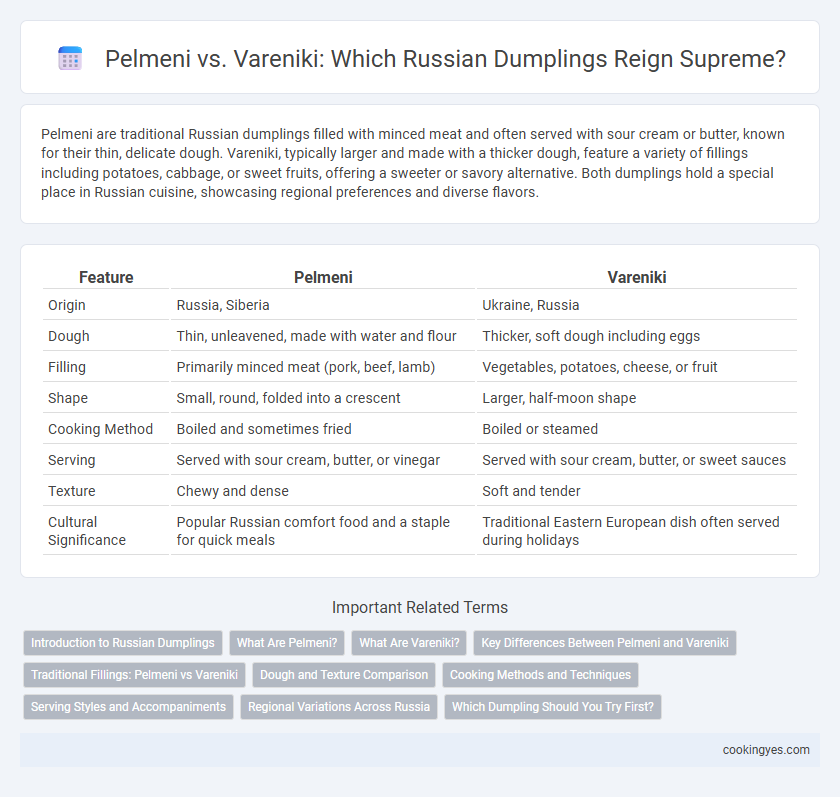Pelmeni are traditional Russian dumplings filled with minced meat and often served with sour cream or butter, known for their thin, delicate dough. Vareniki, typically larger and made with a thicker dough, feature a variety of fillings including potatoes, cabbage, or sweet fruits, offering a sweeter or savory alternative. Both dumplings hold a special place in Russian cuisine, showcasing regional preferences and diverse flavors.
Table of Comparison
| Feature | Pelmeni | Vareniki |
|---|---|---|
| Origin | Russia, Siberia | Ukraine, Russia |
| Dough | Thin, unleavened, made with water and flour | Thicker, soft dough including eggs |
| Filling | Primarily minced meat (pork, beef, lamb) | Vegetables, potatoes, cheese, or fruit |
| Shape | Small, round, folded into a crescent | Larger, half-moon shape |
| Cooking Method | Boiled and sometimes fried | Boiled or steamed |
| Serving | Served with sour cream, butter, or vinegar | Served with sour cream, butter, or sweet sauces |
| Texture | Chewy and dense | Soft and tender |
| Cultural Significance | Popular Russian comfort food and a staple for quick meals | Traditional Eastern European dish often served during holidays |
Introduction to Russian Dumplings
Pelmeni and Vareniki are iconic Russian dumplings, each with distinct regional roots and fillings. Pelmeni typically feature a thin dough encasing minced meat, reflecting Siberian culinary tradition, while Vareniki often contain potatoes, cabbage, or sweet fillings like cherries, common in Ukrainian and Russian cuisines. Both varieties showcase the rich heritage of Russian dumplings, highlighting diverse dough textures and flavor profiles essential to Eastern European gastronomy.
What Are Pelmeni?
Pelmeni are traditional Russian dumplings made from unleavened dough stuffed with minced meat, such as beef, pork, or lamb, often mixed with onions and spices. These dumplings are typically smaller and rounder than vareniki, with a thin, delicate dough that becomes tender after boiling. Pelmeni are usually served hot with sour cream, butter, or vinegar, highlighting their rich, savory filling and robust Russian culinary heritage.
What Are Vareniki?
Vareniki are traditional Ukrainian dumplings made from unleavened dough filled with a variety of ingredients such as potatoes, sauerkraut, cheese, or cherries, often served with sour cream. Unlike pelmeni, which typically contain minced meat and have a thinner dough, vareniki dough is thicker and slightly sweeter, reflecting their Eastern European origin. Vareniki hold cultural significance and are a staple comfort food during holidays and family gatherings in Ukraine and surrounding regions.
Key Differences Between Pelmeni and Vareniki
Pelmeni and vareniki are traditional Russian dumplings with distinct differences in filling and dough texture. Pelmeni typically feature a thin, unleavened dough filled with a mixture of raw minced meat such as beef, pork, or lamb, while vareniki use a thicker, slightly leavened dough often filled with potatoes, cheese, or fruit. Cooking methods also vary; pelmeni are usually boiled and served with sour cream or butter, whereas vareniki can be boiled, fried, or baked and are commonly accompanied by sweet or savory toppings.
Traditional Fillings: Pelmeni vs Vareniki
Pelmeni traditionally feature savory fillings such as minced meat, including pork, beef, or lamb, often mixed with onions and spices that highlight Russian culinary heritage. Vareniki typically contain a wider variety of fillings ranging from savory options like potatoes, cabbage, and mushrooms to sweet fillings like cherries, blueberries, or farmer's cheese, reflecting regional diversity. These filling differences underscore the distinct cultural and taste profiles between pelmeni and vareniki within Russian cuisine.
Dough and Texture Comparison
Pelmeni dough is made with a simple mixture of flour, water, and sometimes eggs, resulting in a thin, elastic wrapper that cooks quickly and has a slightly chewy texture. Vareniki dough typically incorporates eggs and sour cream or milk, creating a thicker, softer, and more tender outer layer that complements its often sweeter or more varied fillings. The difference in dough composition directly influences the texture, with pelmeni offering a firmer bite while vareniki provide a more delicate mouthfeel.
Cooking Methods and Techniques
Pelmeni are traditionally boiled in salted water until they float, then briefly simmered to ensure a tender, juicy texture, often served with butter or sour cream. Vareniki also undergo boiling but sometimes require a longer cooking time due to thicker dough, and are commonly finished with sauteed onions or fried in butter for added flavor. Both dumplings rely on precise dough thickness and sealing techniques to prevent fillings from leaking during cooking.
Serving Styles and Accompaniments
Pelmeni are traditionally served with butter, sour cream, or vinegar, emphasizing a savory profile often accompanied by broth or clear soups. Vareniki are commonly presented with toppings like fried onions, melted butter, or sweet sour cream, highlighting sweet or savory fillings such as potatoes, cheese, or cherries. Both dumpling types reflect regional preferences in Russia by pairing with distinctive sauces and garnishes that enhance their respective flavors.
Regional Variations Across Russia
Pelmeni and vareniki represent distinct regional dumpling traditions across Russia, with pelmeni originating from Siberia and featuring thin dough filled with minced meat, often served with sour cream or broth. Vareniki, popular in Western Russia and Ukraine, typically contain fillings like potatoes, cabbage, or cherries and are slightly thicker, reflecting local agricultural products. These variations highlight Russia's diverse culinary landscape, where regional ingredients and cultural influences shape the preparation and serving of dumplings.
Which Dumpling Should You Try First?
Pelmeni offer a savory experience with their thin dough encasing seasoned meat like beef, pork, or lamb, often enjoyed with sour cream or vinegar, while vareniki provide a sweeter or more diverse filling range, including potatoes, cabbage, cheese, or cherries, catering to both savory and dessert preferences. For those seeking a rich, meaty taste that highlights traditional Russian flavors, pelmeni are the ideal starting point. If versatility and the option to enjoy sweet or vegetarian fillings appeal more, vareniki make a perfect first choice.
Pelmeni vs Vareniki for Russian dumplings Infographic

 cookingyes.com
cookingyes.com